Despite seeming a bit far-fetched, there are numerous innovations created by NASA for space flight that now find alternative applications in the field of medicine. One such invention is a “super plastic,” originally created for high-speed test flights, which has currently found a suitable application as part of implantable heart devices. The material, developed at NASA's Langley Research Center in Hampton, Virginia, has been named Langley Research Center's Soluble Imide, or LaRC-SI, and has since been determined to be biologically inert, which means that it does not interact with living cells inside the human body.
In addition, the stuff can withstand extreme cold and heat, is highly flexible, and also holds together when subjected to the action of a large array of otherwise toxic chemicals. The inventor of the material, NASA Langley senior researcher Rob Bryant, says that, “One of the advantages of this material is that it lends itself to a variety of diverse applications, from mechanical parts and composites to electrical insulation and adhesive bonding. Langley Research Center's Soluble Imide is an excellent example of how taxpayer investment in NASA materials research has resulted in a direct benefit beyond the aerospace sector by extending the quality of life through medical technology.”
The material was first presented to the world in July of 2004, and a patent detailing it has since been obtained, and licensed to Minneapolis-based medical technology company Medtronic Inc. The enterprise promptly introduced the material into its Attain Ability left-heart lead, and submitted it to the Food and Drug Administration (FDA), seeking to get approval for its implementation in day-to-day medical procedures. It was only recently that the federal agency approved the super plastic as part of the Attain Ability device, which means that Medtronic Inc. is now able to apply the technology in future heart implants.
Cardiac resynchronization therapy, or CRT, is one of the few medical options some five million Americans and 22 million people worldwide suffering from heart failure have in dealing with their condition. In CRT, hand-watch-sized devices are implanted into a patient's chest, and connected to the heart via leads, which are special types of wires. When the heart starts acting up, an electrical charge is delivered to the heart via the leads, which resynchronizes the heart beats and also improves blood flow throughout the body.

 14 DAY TRIAL //
14 DAY TRIAL //